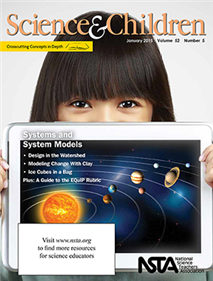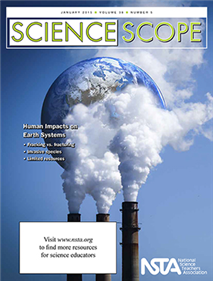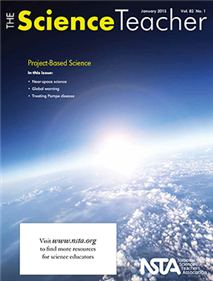All Resources
Journal Article
Fifth-grade students use computer programming to create models that help them understand patterns in Earth and sky....
Journal Article
Fifth-grade students use STEM principles to improve local water quality....
Journal Article
Early childhood students design a piece of playground equipment using 3-D printing technology....
Journal Article
Fourth-grade students explore the river that runs through their town....
Journal Article
Bilingual primary students create imaginary landscapes to model slow changes to Earth's surface....
Journal Article
EQuiP-ped for Success: A Rubric to Help Implement the Next Generation Science Standards
Measure the alignment and overall quality of your lessons and units....
Journal Article
Aliens Invade and Drop Off Litter
Gain an awareness of the environmental problems caused by invasive species....
Journal Article
The Human Impact on Earthquakes: Natural Fracturing Versus Fracking
Investigate the potential connections between human activities and seismic events....
Journal Article
Life With Limited Resources: Using Aquatic Plants to Study Resource Consumption
Grow duckweed to explore resource limitations and consumption....
Journal Article
No Space? Little Money? No Garden? Not So Fast!
Start a cost-effective, compact school garden to teach your students about plant growth....
Journal Article
Plotting Plants: Tracking Invasive Species in the Local Community
Overcome "plant blindness" with a study of invasive species....
Journal Article
Editor's Roundtable: Branching Out on the Family Tree
Science Scope’s editor shares thoughts regarding the current issue....
Journal Article
Guest Editorial: Making the Most of Your Outdoor Classroom
An opinion piece about how to create an outdoor learning center and incorporate relevant lessons....
Journal Article
Tried and True: A Water Cycle of Many Paths
This column provides classic demonstrations and experiments with a new twist. This month’s issue describes an activity that allows students to explore the complexity of the water cycle, create their own model of it, and connect it to the processes ...
Journal Article
Scope on Safety: Safety on the Move
This column shares safety information for your classroom. This month’s issue discusses safety related to hands-on activities for the study of force and motion....
Journal Article
Scope on the Skies: A New Year, A New World View
This column focuses on astronomy throughout the year. This month’s issue takes a look at Earth through the eyes of some of the many Earth-observing satellites....
Journal Article
Editor's Note: Systems and System Models
Science and Children’s editor shares thoughts regarding the current issue....
Journal Article
The Early Years: Exploring Systems
This column discusses resources and science topics related to students in grades preK to 2. This month’s issue describes a lesson that connects across several early childhood standards, including engineering design....
Journal Article
Formative Assessment Probes: Ice Cubes in a Bag
This column focuses on promoting learning through assessment. This month’s issue discusses how to uncover children's ideas about open and closed systems....
Journal Article
Teaching Through Trade Books: What's the Big Deal About Bees?
This column includes activities inspired by children’s literature. In this month’s issue students explore the essential role of bees in our ecosystems and why the loss of bees is a very big deal....
Journal Article
Science 101: How Should We Use the Concept of Systems?
This column provides background science information for elementary teachers. This month’s issue provides activities to help explain how to teach about systems....
Journal Article
Methods and Strategies: The Future of Farming
This column provides ideas and techniques to enhance your science teaching. This month’s issue describes an integrated, multidisciplinary unit that introduces second-grade students to hydroponic gardening....
Journal Article
Engineering Encounters: A System of Systems
A STEM investigation project for intermediate students has real-life connections....
Journal Article
A ballooning project to engage students with space beyond the big screen....
Journal Article
Project-based science inspired by the Intergovernmental Panel on Climate Change....
Journal Article
Engaging students and community partners in project-based science....
Journal Article
Measure the alignment and overall quality of your lessons and units with a rubric to help implement the Next Generation Science Standards....
Journal Article
Editor's Corner: Project-Based Science Learning
The Science Teacher’s editor shares thoughts on the current issue....
Journal Article
Science 2.0: Collaborative Data Collection via Google Forms
This column shares web tools that support learning. This month’s issue describes a collaborative model of data collection....
Journal Article
The Green Room: Symbiotic Relationships
This column focuses on making your teaching more environmentally friendly. This month’s issue discusses activities that explore symbiotic relationships....
Journal Article
Health Wise: Pardon Me? Helping Students Avoid Noise-Induced Hearing Loss
This Q&A style column provides up-to-date information on current health topics—helping students (and teachers) make healthy choices. This month’s issue discusses ways students can learn about noise-induced hearing loss....
Journal Article
Career of the Month: Research Chemist
This column shares interviews with professionals using science in the workplace. This month’s issue describes Joseph Parker's career path to becoming a research chemist....
Journal Article
Safer Science: Avoiding Irritants in the Lab
This column provides best safety practices for the science classroom and laboratory. This month’s issue gives guidelines for using irritants safely....





